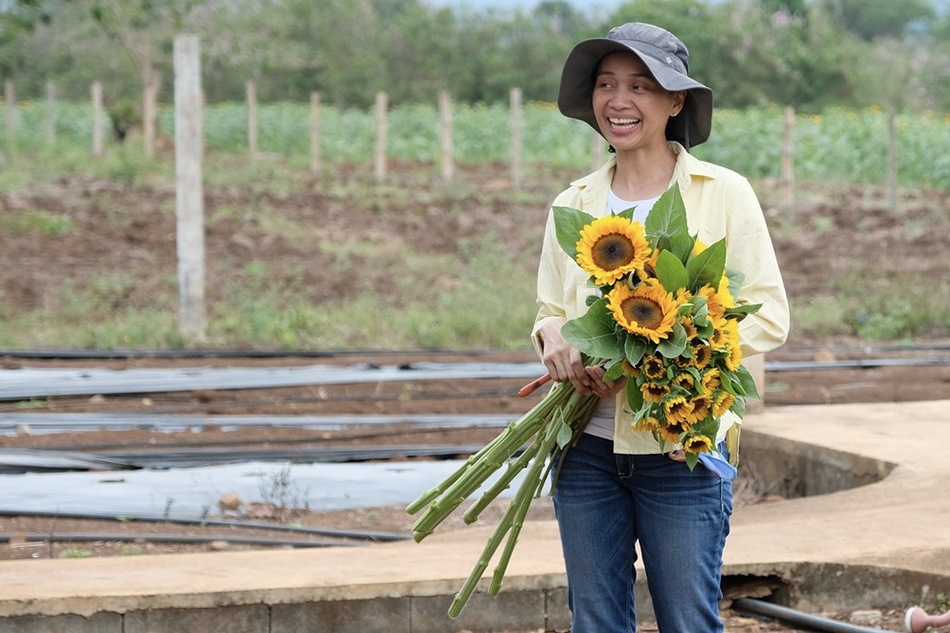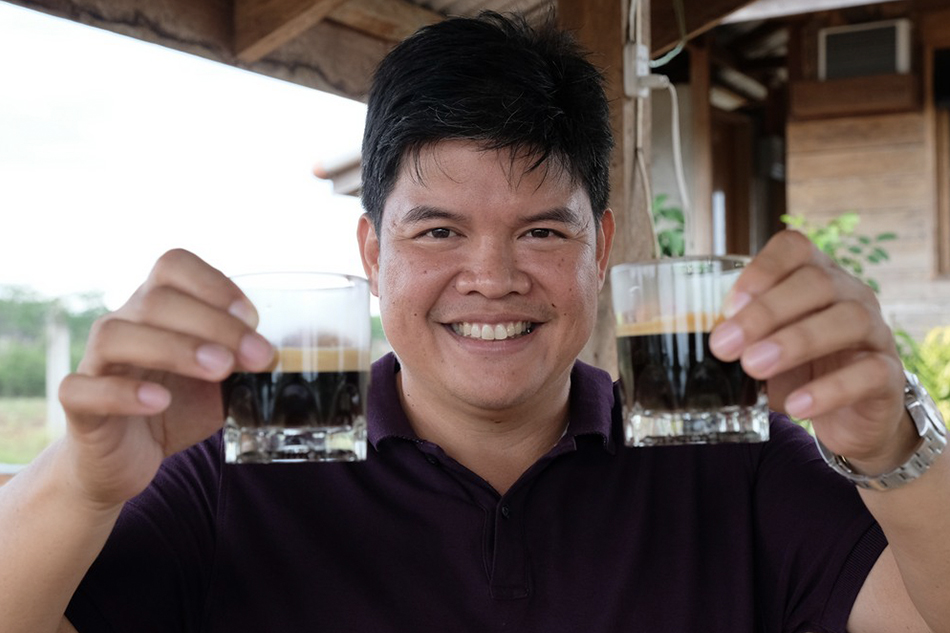This Bukidnon coffee farmer is bringing Robusta back into the spotlight | ABS-CBN
ADVERTISEMENT

Welcome, Kapamilya! We use cookies to improve your browsing experience. Continuing to use this site means you agree to our use of cookies. Tell me more!
This Bukidnon coffee farmer is bringing Robusta back into the spotlight
This Bukidnon coffee farmer is bringing Robusta back into the spotlight
Jeeves De Veyra
Published Mar 25, 2020 12:36 PM PHT
|
Updated Mar 20, 2025 06:57 PM PHT
There was a time when Robusta coffee beans were snubbed by specialty coffee drinkers. Known for its strong and brash characteristics, Robusta was more of an extender and a sidekick to Arabica, the darling of coffeeholics worldwide because of its different region-specific tasting notes.
There was a time when Robusta coffee beans were snubbed by specialty coffee drinkers. Known for its strong and brash characteristics, Robusta was more of an extender and a sidekick to Arabica, the darling of coffeeholics worldwide because of its different region-specific tasting notes.
But that’s all changing as coffee farmers like Raymund Mirabueno are training the spotlight on Robusta.
But that’s all changing as coffee farmers like Raymund Mirabueno are training the spotlight on Robusta.
Bukidnon Robusta in particular as Mirabueno Coffee took home awards at the 2019 Agence por la Valorisation des Produits Agricole (AVPA) Locally Roasted Coffees competition, which wrapped up in Milan last October. His collaboration with Coffee Heritage Project and Manila Based roaster, SGD Coffee, competed against roasters from all over the world to win the Gourmet diploma for the “Puissant Doux”–“Powerful Soft” category described as “strong coffee with softness in the mouth at the end.”
Bukidnon Robusta in particular as Mirabueno Coffee took home awards at the 2019 Agence por la Valorisation des Produits Agricole (AVPA) Locally Roasted Coffees competition, which wrapped up in Milan last October. His collaboration with Coffee Heritage Project and Manila Based roaster, SGD Coffee, competed against roasters from all over the world to win the Gourmet diploma for the “Puissant Doux”–“Powerful Soft” category described as “strong coffee with softness in the mouth at the end.”
You may also like:
You may also like:
At the prodding of a common caffeine-addicted friend, I touched base with Raymund during a recent trip to Cagayan De Oro where he and his wife Gakky call home. I had the good fortune to visit the Mirabueno farm, and geek out about coffee and what it takes to grow world-class Robusta.
At the prodding of a common caffeine-addicted friend, I touched base with Raymund during a recent trip to Cagayan De Oro where he and his wife Gakky call home. I had the good fortune to visit the Mirabueno farm, and geek out about coffee and what it takes to grow world-class Robusta.
ADVERTISEMENT
Raymund became a farmer about 20 years ago. When you meet him, he doesn’t strike one as a traditional farmer in a sense. He has a corporate job and he lives in the city. However, he is privileged to be able to visit his farm up in Bukidnon, which he runs with his wife Gakky, every morning before going to work.
Raymund became a farmer about 20 years ago. When you meet him, he doesn’t strike one as a traditional farmer in a sense. He has a corporate job and he lives in the city. However, he is privileged to be able to visit his farm up in Bukidnon, which he runs with his wife Gakky, every morning before going to work.
The farm is stunning. A large field of yellow covers a huge portion of the farm where the Mirabuenos grow sunflowers. These flowers are huge! These are the kinds that are the centerpiece of a bouquet rather than the teeny-tiny ones used to fill up a bunch. “If you bought a sunflower in Dangwa last Valentine’s Day. It probably came from this field,” Raymund beams with pride.
The farm is stunning. A large field of yellow covers a huge portion of the farm where the Mirabuenos grow sunflowers. These flowers are huge! These are the kinds that are the centerpiece of a bouquet rather than the teeny-tiny ones used to fill up a bunch. “If you bought a sunflower in Dangwa last Valentine’s Day. It probably came from this field,” Raymund beams with pride.
Sunflowers are one thing, but I was here for the coffee.
Sunflowers are one thing, but I was here for the coffee.
On the way up, Raymund narrated how he got into the coffee business. Back in 2006, Nestle gave out coffee seedlings to farmers as a way to encourage local growers. It soon became unsustainable as the buying price of coffee was just too low. At PHP 70 per kilo, it just wasn’t going to support him. Hence, he soon forgot about the 700 trees he planted to focus on other endeavors.
On the way up, Raymund narrated how he got into the coffee business. Back in 2006, Nestle gave out coffee seedlings to farmers as a way to encourage local growers. It soon became unsustainable as the buying price of coffee was just too low. At PHP 70 per kilo, it just wasn’t going to support him. Hence, he soon forgot about the 700 trees he planted to focus on other endeavors.
Raymund is a pragmatic farmer, saying he has failed a number of times. He stresses that farmers should also be salesmen. Before planting anything, farmers must know where they can sell their harvest at sustainable prices.
Raymund is a pragmatic farmer, saying he has failed a number of times. He stresses that farmers should also be salesmen. Before planting anything, farmers must know where they can sell their harvest at sustainable prices.
“You lose so much money and time here. As in fact disappear! It can really frustrate you. Many tears have been shed to come up with an award-winning yield only to find out that your crop will be sold for PHP 1 per kilo. You just park on the side of the road, throw away your crop, then save whatever’s left in your gas tank.”
“You lose so much money and time here. As in fact disappear! It can really frustrate you. Many tears have been shed to come up with an award-winning yield only to find out that your crop will be sold for PHP 1 per kilo. You just park on the side of the road, throw away your crop, then save whatever’s left in your gas tank.”
For some time, coffee was a losing proposition.
For some time, coffee was a losing proposition.
That is, until he met Rich Watanabe and Butch Acop. The two men were part of The Coffee Heritage Project (TCHP) who helped him rediscover his coffee. The two men taught the Raymund best practices when it came to harvesting and processing his crop. More importantly, the two men showed his his coffee can be sold for three to four times the price.
That is, until he met Rich Watanabe and Butch Acop. The two men were part of The Coffee Heritage Project (TCHP) who helped him rediscover his coffee. The two men taught the Raymund best practices when it came to harvesting and processing his crop. More importantly, the two men showed his his coffee can be sold for three to four times the price.
Different people like different coffee. Some like it black, some like it strong, some like it weak, some like it with milk. Some like it super sweet.
Different people like different coffee. Some like it black, some like it strong, some like it weak, some like it with milk. Some like it super sweet.
But one thing for sure is that there is a certain range where coffee is good enough to be drinkable and delicious.
But one thing for sure is that there is a certain range where coffee is good enough to be drinkable and delicious.
“If we compare that to a school grading sheet. That would be like 85 to 95 percent that range. Now, if you want to bring that 85 to 95 percent to 96 to 97 percent, you're really going to exert a lot of effort, and money and position to bring it up higher,”
“If we compare that to a school grading sheet. That would be like 85 to 95 percent that range. Now, if you want to bring that 85 to 95 percent to 96 to 97 percent, you're really going to exert a lot of effort, and money and position to bring it up higher,”
It was this collaboration with the Coffee Heritage Project and SGD Coffee that made his beans break into the 96-97 percent range. The road to Milan started in May of 2019. It was a long process of roasting and cupping to get it right. The result even surprised Raymund as the beans that were sent were darker than his usual roast. But in the end, his Robusta ended up side-by-side among the world’s best coffee.
It was this collaboration with the Coffee Heritage Project and SGD Coffee that made his beans break into the 96-97 percent range. The road to Milan started in May of 2019. It was a long process of roasting and cupping to get it right. The result even surprised Raymund as the beans that were sent were darker than his usual roast. But in the end, his Robusta ended up side-by-side among the world’s best coffee.
So how does world class Robusta taste like?
So how does world class Robusta taste like?
Raymund brought me to a cabana in the middle of the farm where a Coffee Heritage Project supplied automatic espresso machine is ready to brew espressos. The coffee is almost white forming a thick rich crema as it drips out of the machine, a sign of freshly roasted beans.
Raymund brought me to a cabana in the middle of the farm where a Coffee Heritage Project supplied automatic espresso machine is ready to brew espressos. The coffee is almost white forming a thick rich crema as it drips out of the machine, a sign of freshly roasted beans.
The resulting cup was still strong but still tasting notes of dark chocolate and citrus. Letting it cool a little, the flavors become more pronounced leaving out any doubts that this run-of-the-mill Robusta.
The resulting cup was still strong but still tasting notes of dark chocolate and citrus. Letting it cool a little, the flavors become more pronounced leaving out any doubts that this run-of-the-mill Robusta.
On the drive back to the city, Raymund shared his advocacy of sharing his blessings with other coffee farmers. One of the ways he does this is encouraging coffee lovers to buy local and buy at correct prices. Whenever he can, he gets the farmers to meet the drinkers and buyers directly though coffee festivals.
On the drive back to the city, Raymund shared his advocacy of sharing his blessings with other coffee farmers. One of the ways he does this is encouraging coffee lovers to buy local and buy at correct prices. Whenever he can, he gets the farmers to meet the drinkers and buyers directly though coffee festivals.
He tells his fellow farmers in Bukidnon that if he can do it and if he can sell his coffee at the right prices, so can they.
He tells his fellow farmers in Bukidnon that if he can do it and if he can sell his coffee at the right prices, so can they.
It is hard work as risk-averse fellow farmers are initially skeptical, even suspicious, of his offer to help. But for those he’s able to bring to a coffee festival tasting bar, seeing coffee lovers’ reactions to their beans, as well, as their being able to get the buyers to buy beans directly from the growers at the right price is all worth it.
It is hard work as risk-averse fellow farmers are initially skeptical, even suspicious, of his offer to help. But for those he’s able to bring to a coffee festival tasting bar, seeing coffee lovers’ reactions to their beans, as well, as their being able to get the buyers to buy beans directly from the growers at the right price is all worth it.
The over-arching vision is to make local specialty coffee more present in Filipino’s lives.
The over-arching vision is to make local specialty coffee more present in Filipino’s lives.
These days, coffee is equated to the ever-present 3-in-1 packs. While these are sufficient for a quick jolt, the sugar and chemicals in these packs can be quite unhealthy.
These days, coffee is equated to the ever-present 3-in-1 packs. While these are sufficient for a quick jolt, the sugar and chemicals in these packs can be quite unhealthy.
He said there were cities and municipalities interested in having carts where street baristas would brew coffee on the streets similar to the Caphe Sua Da stalls in Vietnam. This way, there would be more demand for beans from the farmers and give Filipinos an appreciation for locally produced coffee.
He said there were cities and municipalities interested in having carts where street baristas would brew coffee on the streets similar to the Caphe Sua Da stalls in Vietnam. This way, there would be more demand for beans from the farmers and give Filipinos an appreciation for locally produced coffee.
This is a vision where everybody wins. Farmers like Raymund MIrabueno who will still be growing world-class beans, and coffee drinkers like you and me, who’ll be happy to get our morning buzz from our own coffee.
This is a vision where everybody wins. Farmers like Raymund MIrabueno who will still be growing world-class beans, and coffee drinkers like you and me, who’ll be happy to get our morning buzz from our own coffee.
PHOTOGRAPHS BY JEEVES DE VEYRA
PHOTOGRAPHS BY JEEVES DE VEYRA
ADVERTISEMENT
ADVERTISEMENT





